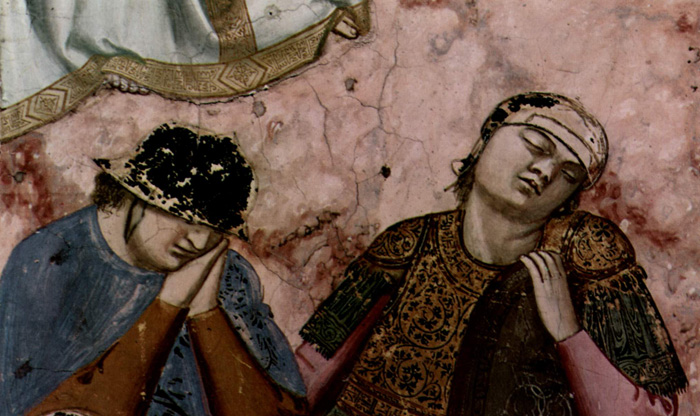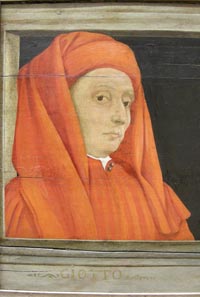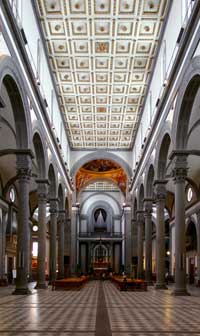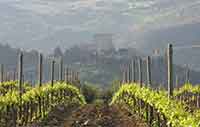Masterpieces and artists of the Italian Renaissance |
| Prior to the Renaissance, the Italian language was not the literary language in Italy. It was only in the 13th century that Italian authors began writing in their native language rather than Latin, French, or Provençal. The 1250s saw a major change in Italian poetry as the Dolce Stil Novo (Sweet New Style, which emphasized Platonic rather than courtly love) came into its own, pioneered by poets like Guittone d'Arezzo and Guido Guinizelli. Especially in poetry, major changes in Italian literature had been taking place decades before the Renaissance truly began. Indeed, the 13th-century Italian literary revolution helped set the stage for the Renaissance. An increasing number of works began to be published in the Italian vernacular. Simultaneously, the source for these works shifted away from religion and towards the pre-Christian eras of Imperial Rome and Ancient Greece. This is not to say that no religious works were published in this period: Dante Alighieri's The Divine Comedy reflects a distinctly medieval worldview. Christianity remained a major influence for artists and authors, with the classics coming into their own as a second primary influence. In the early Renaissance, especially in Italy, much of the focus was on translating and studying classic works from Latin and Greek. Both the cultures were highly admired in the Renaissance, especially after the newly labelled Dark Ages. Renaissance authors were not content to rest on the laurels of ancient authors, however. Many authors attempted to integrate the methods and styles of the ancient greats into their own works. Among the most emulated Romans are Cicero, Horace, Sallust, and Virgil. Among the Greeks, Aristotle, Homer, Plato, and Socrates were also heavily emulated by Renaissance authors. The literature and poetry of the Renaissance was also largely influenced by the developing science and philosophy. The humanist Francesco Petrarch, a key figure in the renewed sense of scholarship, was also an accomplished poet, publishing several important works of poetry. He wrote poetry in Latin, notably the Punic War epic Africa, but is today remembered for his works in the Italian vernacular, especially the Canzoniere, a collection of love sonnets dedicated to his unrequited love Laura. He was the foremost writer of sonnets in Italian, and translations of his work into English by Thomas Wyatt established the sonnet form in that country, where it was employed by William Shakespeare and countless other poets. Petrarch's disciple, Giovanni Boccaccio, became a major author in his own right. His major work was the Decameron, a collection of 100 stories told by ten storytellers who have fled to the outskirts of Florence to escape the black plague over ten nights. The Decameron in particular and Boccaccio's work in general were a major source of inspiration and plots for many English authors in the Renaissance, including Geoffrey Chaucer and William Shakespeare, and beyond. Aside from Christianity, classical antiquity, and scholarship, a fourth influence on Renaissance literature was politics. The political philosopher Niccolò Machiavelli is an important Italian author. His most famous work is The Prince, which has become so well-known in Western society that the term "Machiavellian" has come into use, referring to the self-serving attitude advocated by the book. However, most experts agree that Machiavelli himself did not fully embrace the tactics in his book, making "Machiavellian" a slightly inaccurate term. Regardless, along with many other Renaissance works, The Prince remains a relevant and influential work of literature today. Science and philosophy |
||
Petrarch is considered by many to be the founder of a new method of scholarship known as Renaissance Humanism. Humanism saw man as a rational and sentient being with the ability to decide and think for himself. This was a rejection of the Catholic Church's vision of souls as the only absolute reality, which was then seen as mystical and imaginary. It saw man as inherently good by nature which is in contrast to the Christian view of man as the original sinner who must be redeemed. It provoked fresh insight into the nature of reality, questioning beyond God and spirituality, and provided for knowledge about history beyond Christian history. |
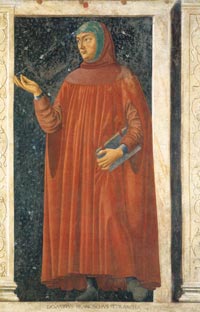 Andrea del Castagno, Francesco Petrarca, from the Cycle of Famous Men and Women, c. 1450. Detached fresco. 247 x 153 cm. Galleria degli Uffizi, Firenze. |
|
| In Italy in the 14th century there was an explosion of musical activity that corresponded in scope and level of innovation to the activity in the other arts. Although musicologists typically group the music of the trecento with the late medieval period, it included features which align with the early Renaissance in important ways: an increasing emphasis on secular sources, styles and forms; a spreading of culture away from ecclesiastical institutions to the nobility, and even to the common people; and a quick development of entirely new techniques. The principal forms were the trecento madrigal, the caccia, and the ballata. Overall, the musical style of the period is sometimes labelled as the "Italian ars nova." See Music of the trecento for more detail on this period. From the early 15th century to the middle of the 16th century, the center of innovation in sacred music was in the Low Countries, and a flood of talented composers came to Italy from this region. Many of them sang in either the papal choir in Rome or the choirs at the numerous chapels of the aristocracy, in Rome, Florence, Milan, Ferrara and elsewhere; and they brought their polyphonic style with them, influencing many native Italian composers during their stay. The predominant forms of church music during the period were the mass and the motet. By far the most famous composer of church music in 16th century Italy was Palestrina, the most prominent member of the Roman School, whose style of smooth, emotionally cool polyphony was to become the defining sound of the late 16th century, at least for generations of 19th- and 20th century musicologists. Other Italian composers of the late 16th century focused on composing the main secular form of the era, the madrigal: and for almost a hundred years these secular songs for multiple singers were distributed all over Europe. Composers of madrigals included Jacques Arcadelt, at the beginning of the age, Cipriano de Rore, in the middle of the century, and Luca Marenzio, Philippe de Monte, Carlo Gesualdo, and Claudio Monteverdi at the end of the era. Italy was also a centre of innovation in instrumental music. By the early 16th century keyboard improvisation came to be greatly valued, and numerous composers of virtuoso keyboard music appeared. Many familiar instruments were invented and perfected in late Renaissance Italy, such as the violin, the earliest forms of which came into use in the 1550s. By the late 16th century Italy was the musical centre of Europe. Almost all of the innovations which were to define the transition to the Baroque period originated in northern Italy in the last few decades of the century. In Venice, the polychoral productions of the Venetian School, and associated instrumental music, moved north into Germany; in Florence, the Florentine Camerata developed monody, the important precursor to opera, which itself first appeared around 1600; and the avant-garde, manneristic style of the Ferrara school, which migrated to Naples and elsewhere through the music of Carlo Gesualdo, was to be the final statement of the polyphonic vocal music of the Renaissance. Sculpture and painting |
||
Sculpture was the first of the fine arts to display Renaissance traits. Donatello (1386–1466) was one of the most notable sculptors of the early Renaissance. He returned to classical techniques such as contrapposto and classical subjects like the unsupported nude – his second sculpture of David was the first free-standing bronze nude created in Europe since the Roman Empire. About a century later Michelangelo developed figures that were completely independent of any architectural structure surrounding them. His statue of David is also a nude study; Michelangelo's David however is moving in a more natural way. Both sculptures are standing in contrapost, their weight shifted to one leg. Italian artists Giotto di Bondone (1267-1337)
|
|
|
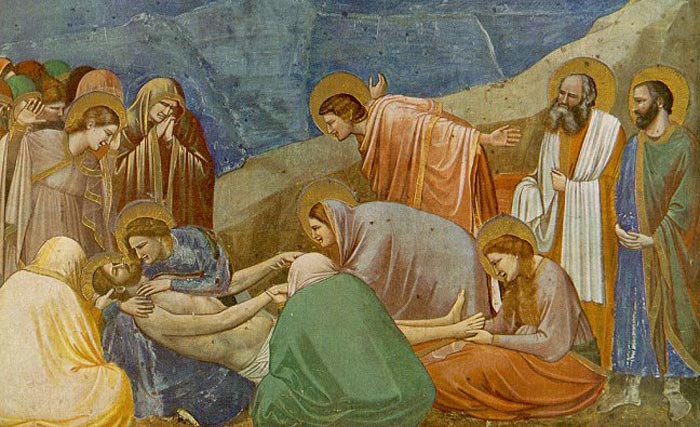 |
||
Giotto, Scenes from the Life of Christ, Lamentation (The Mourning of Christ), 1304-06, Cappella Scrovegni (Arena Chapel), Padua |
||
Giotto di Bondone (c. 1267 – January 8, 1337), better known simply as Giotto, was an Italian painter and architect from Florence in the late Middle Ages. He is generally considered the first in a line of great artists who contributed to the Italian Renaissance. |
||
| Masaccio born in 1401, died in 1428. Perhaps one of the most influential artists of the Renaissance. Historians claim that he, along with Donatello and Brunelleschi, inspired the style of art that typifies art of the period. In his 27 years on the planet, he developed a style that used perspective in a way that created an illusion of three-dimensions--a significant change from the flat style of painting that typified medieval art. His most famous work can be found in the Brancacci Chapel in Santa Maria del Carmine in Florence. |
||
| Ghiberti born in 1378, died 1455. Exceptional bronze sculpture, most famous for being selected to do the doors to the baptistry of the doors of the Duomo in Florence, being chosen over such artists as Brunelleschi and Donatello. Some art historians define the entries submitted in this contest as the beginning point of Renaissance art. Ghiberti spent 21 years doing the north doors. The year after he completed those doors, he was commissioned to do the east doors. He spent the next 28 years producing the brass panels depicting the Old Testament that complete those doors which Michelangelo described as the "gates of Paradise." He also sculpted St. Matthew and St. John the Baptist out of bronze for the Orsanmichele in Florence. | ||
Architecture Like painting, Renaissance architecture was inspired by the Classical. In Italy, the Renaissance style first started to develop in Florence. Some of the earliest buildings showing Renaissance characteristics are Filippo Brunelleschi's sacral buildings S. Lorenzo and the Pazzi Chapel. The interior of S. Spirito expresses a new sense of light clarity and spaciousness, which is typical of the early Italian Renaissance (1420 to 1500). The architecture reflects the philosophy of Humanism, the enlightenment and clarity of mind as opposed to the darkness and spirituality of the Middle Ages. The revival of classical antiquity can best be illustrated by the Palazzo Ruccelai. Here the columns follow the classical orders. The columns are topped by Doric capitals on the ground floor, Ionic capitals on the first floor and Corinthian capitals on the second floor. * Santa Maria del Fiore |
||
| Brunelleschi, born in 1377, died in 1446. Architect in Florence that made the cupola of the Florence cathedral. The Duomo of Florence has become the symbol of Florence, is its tallest building and is a symbol of the wealth and civic pride of the affluent families of the city during the Renaissance. The church, on which construction began in 1299, is crowned by the massive dome designed by Brunelleschi almost two centuries later. This building did not have a roof for 175 years because it posed a major architectural challenge with the large area the dome had to span. You can climb 463 steps up the dome and view the city below. Seven of the great artists of Florence, including Brunelleschi and Donatello, competed for the opportunity to make these doors (and earn the stipend for the work). Beyond his abilities as an architect, Brunelleschi was recognized for using geometric principles in creating perspective and influencing both Masaccio and Donatello to follow that style. |
||
| Giorgio Vasari, (born July 30, 1511, Arezzo [Italy]—died June 27, 1574, Florence), Italian painter, architect, and writer who is best known for his important biographies of Italian Renaissance artists. When still a child, Vasari was the pupil of Guglielmo de Marcillat, but his decisive training was in Florence, where he enjoyed the friendship and patronage of the Medici family, trained within the circle of Andrea del Sarto, and became a lifelong admirer of Michelangelo. As an artist Vasari was both studious and prolific. His painting is best represented by the fresco cycles in the Palazzo Vecchio in Florence and by the so-called 100-days fresco, which depicts scenes from the life of Pope Paul III, in the Cancelleria in Rome. Vasari’s paintings, often produced with the help of a team of assistants, are in the style of the Tuscan Mannerists and have often been criticized as being facile, superficial, and lacking a sense of colour. Contemporary scholars regard Vasari more highly as an architect than as a painter. His best-known buildings are the Uffizi in Florence, begun in 1560 for Cosimo I de’ Medici, and the church, monastery, and palace created for the Cavalieri di San Stefano in Pisa. The Vasari Corridor is an elevated enclosed passageway in Florence, central Italy, which connects the Palazzo Vecchio with the Palazzo Pitti in Florence. The Corridor was built in 1564 by Giorgio Vasari in only five months at the time of the wedding between Francesco I de' Medici and Giovanna of Austria; it served to link up the Pitti Palace, where the Grand Duke resided, with the Uffizi (or offices) where he worked. Vasari’s fame rests on his massive book Le Vite de’ più eccellenti architetti, pittori, et scultori italiani… (1550, 2nd ed., 1568), which was dedicated to Cosimo de’ Medici. In the Lives of the Most Eminent Painters, Sculptors, and Architects Vasari offers his own critical history of Western art through several prefaces and a lengthy series of artist biographies. These discussions present three periods of artistic development: according to Vasari, the excellence of the art of classical antiquity was followed by a decline of quality during the Dark Ages, which was in turn reversed by a renaissance of the arts in Tuscany in the 14th century, initiated by Cimabue and Giotto and culminating in the works of Michelangelo. A second and much-enlarged edition of Lives, which added the biographies of a number of artists then living, as well as Vasari’s own autobiography, is now much better known than the first edition and has been widely translated. Art in Tuscany | The Vasari Corridor |
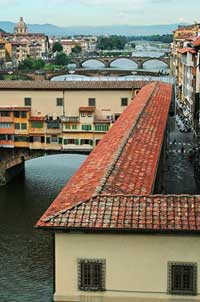 The West Corridor of the Gallery, heads towards the Arno and then, raised up by huge arches, follows the river as far as the Ponte Vecchio, which it crosses by passing on top of the shops. The meat market on the bridge was at this time trasferred elsewhere, so as not to offend the Grand Duke's sensitive nose with unpleasant smells on his walk, and replaced (from 1593) with the goldsmiths who continue to work there today. |
|
|
||||
| Wine regions | Podere Santa Pia |
Podere Santa Pia, view from the garden on the valley below |
||
[1] |
||||
| This article uses material from the Wikipedia article "Italian Renaissance" and is published under the GNU Free Documentation License. |
||||
Alberti, Leon Battista. On Painting . Tr. John R. Spencer. New Haven: Yale University Press, 1956. Bender, Michael. Waiting for Filippo, a Pop-up Book . San Francisco: Chronicle Books, 1995. Bennett, Bonnie A. and David G. Wilkins. Donatello. Oxford: Phaidon, 1984. Bertela, Giovanna Gaeta. Donatello. Firenze: Scala, 1991. Boase, T.S.R. Giorgio Vasari: The Man and the Book . Washington: The National Gallery of Art, 1979. Borsi, Franco. Leon Battista Alberti: The Complete Works . New York: Electa/Rizzoli, 1989. Casazza, Ornella. Masaccio and the Brancacci Chapel. Siena: Scala, 1990. Chastel, Andre. The Flowering of the Italian Renaissance , tr. Jonathan Griffin. Arts of Mankind. New York: Odyssey, 1965. Jestaz, Bertrand. Architecture of the Renaissance from Brunelleschi to Palladio. New York: Abrams, 1996. Joannides, Paul. Masaccio and Masolino: A Complete Catalogue . London: Phaidon, 1993. Keizer, Joost. History, origins, recovery : Michelangelo and the politics of art. Krautheimer, Richard. Ghiberti's Bronze Doors. Princeton: Princeton University Press, 1971. Lightbrown, Ronald. Piero della Francesca. New York: Abbeville, 1992. Lloyd, Christopher. Fra Angelico , rev. ed. London: Phaidon, 1992. Micheletti, Emma. Domenico Ghirlandaio. Milano: Scala, 1990. Pope-Hennessy, Sir John. Donatello: Sculptor. New York: Abbeville, 1993.
|
||||

